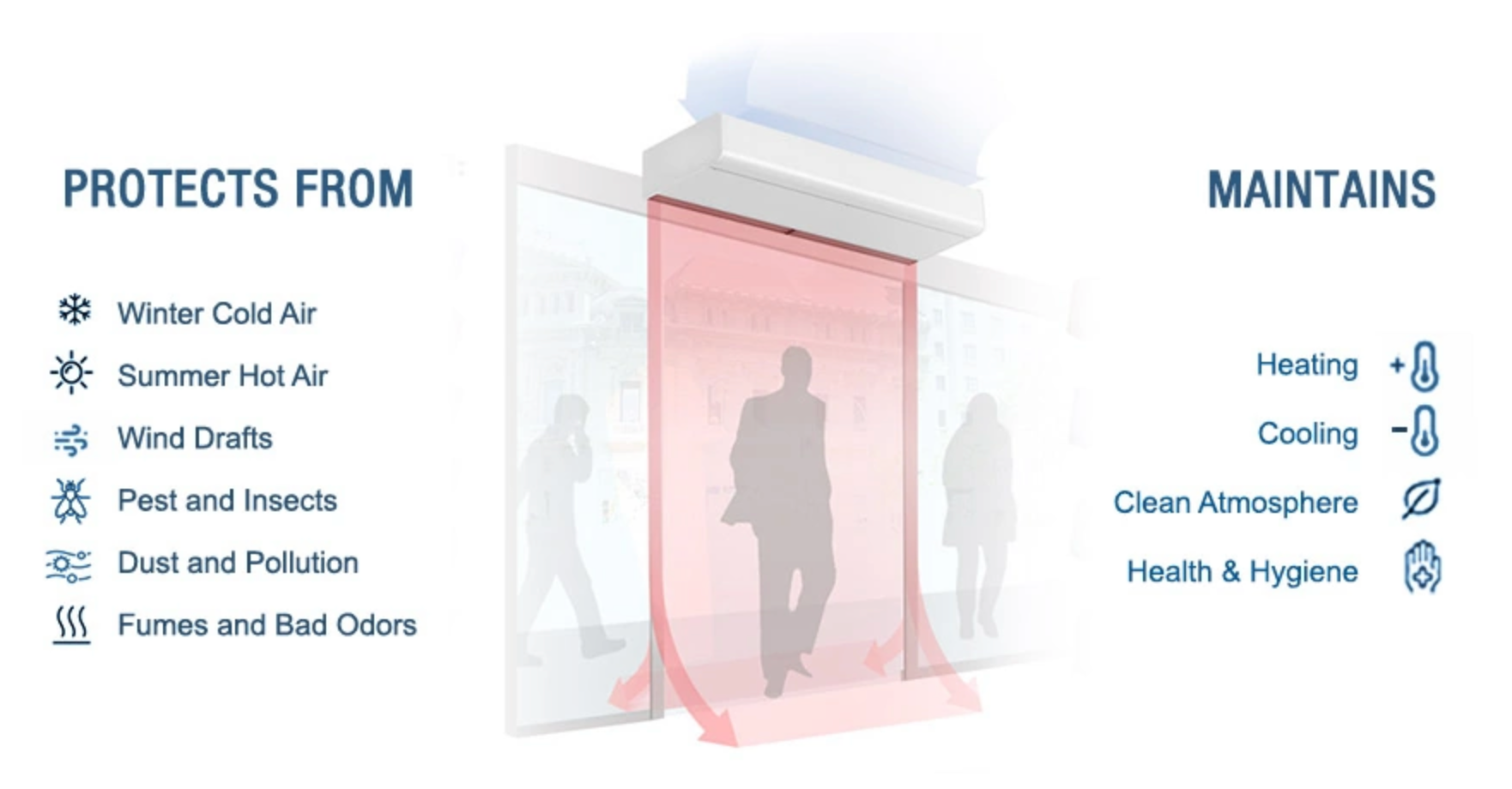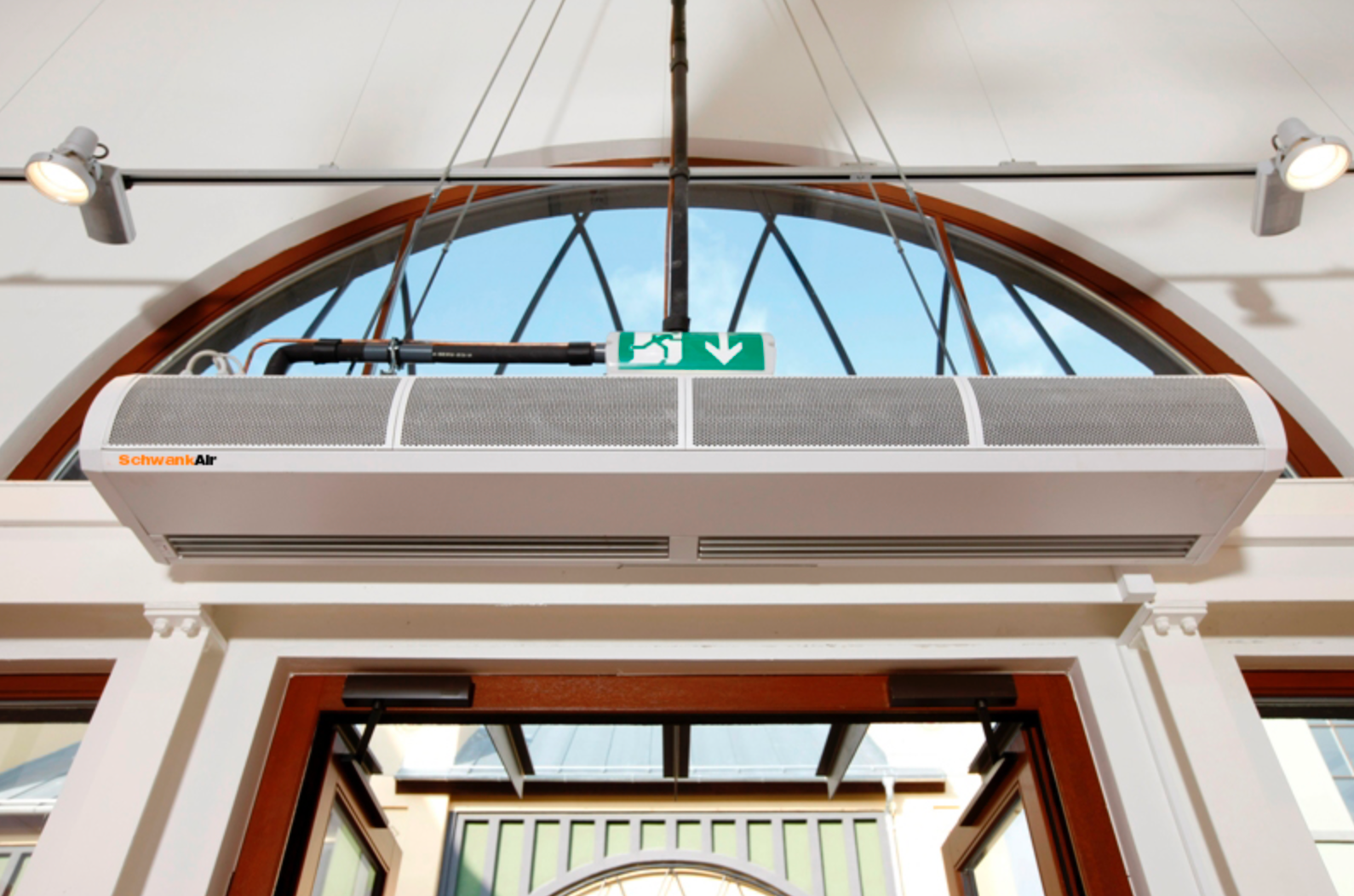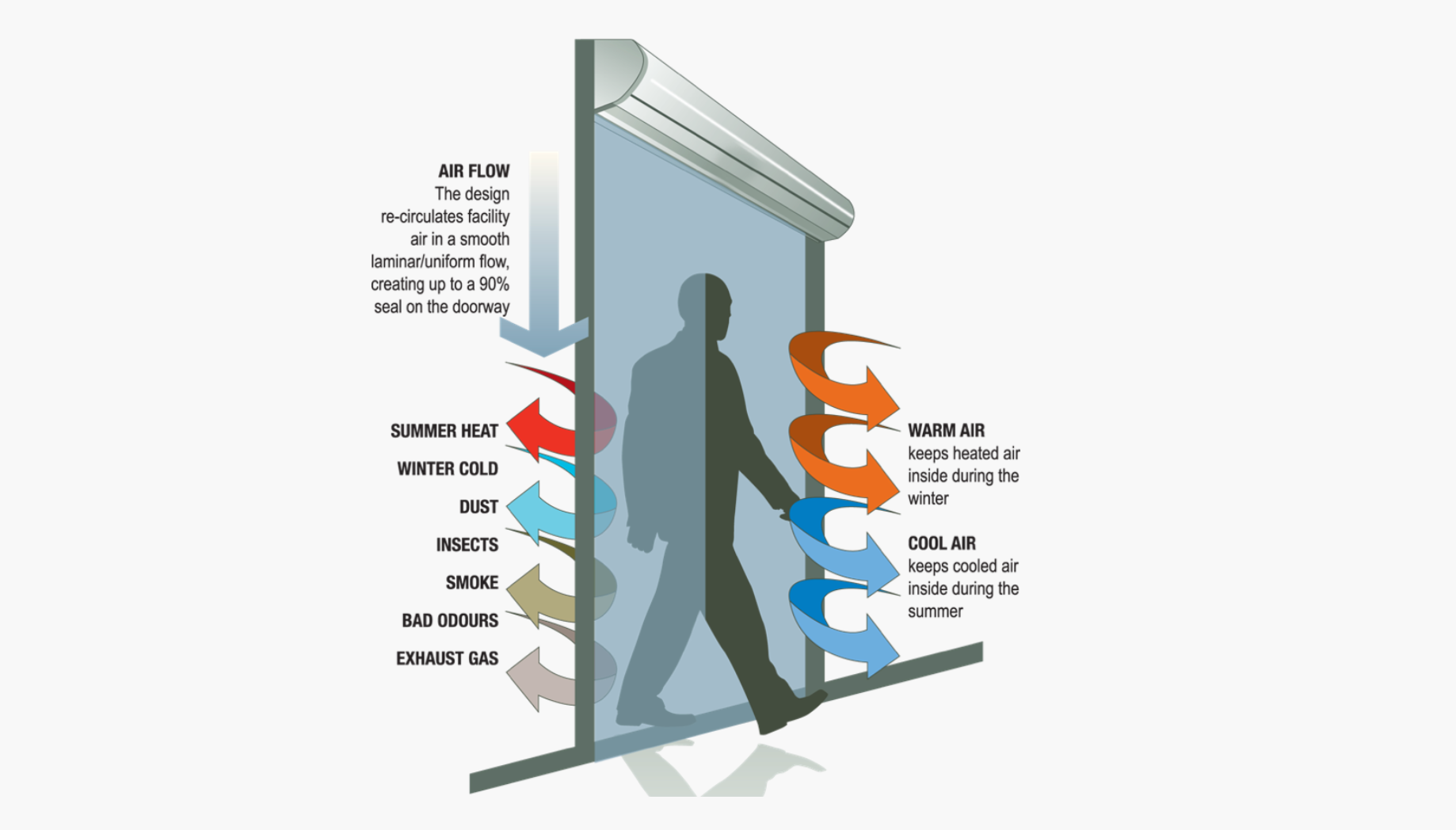
Air Curtain Technology
An air curtain is a fan-powered device that creates an invisible high-velocity air barrier over a doorway or entrance. This air barrier efficiently separates two different environments without limiting the access of people or vehicles.
An air curtain can help to reduce heating and cooling costs by up to 80% while protecting the indoor environment, increasing personal comfort.
Air curtains maintain the indoor environment and dramatically reduce the intrusion of pests and insects, dust, airborne, pollution, smells, and odors. Air curtains significantly reduce drafts of cold or hot air at entrances and doorways.
Heated air curtains are also available. These maintain temperatures using warm air that helps to create a comfortable environment.
Are air curtains effective?
Absolutely!
Generally, the air entering through the inlet grille is compressed by internal fans and forced through an air outlet directed at the open doorway.
All studies and tests have proven that air curtains are effective. When an efficient air curtain is properly installed, it saves considerable amounts of energy. At the same time, the entrance areas remain climate protected, comfortable, and free of draughts, insects, odors, etc.
The following advanced Computational Fluid Dynamics CFD diagrams made by UPC (Polytechnic University of Catalunya) clearly show the efficiency of air curtains.
The diagrams below are divided into two parts (at X=2): the left side simulates an indoor environment with a heater on the wall, and the right side simulates an outdoor environment.
The air curtain placed on top divides the warm and cold areas into two thermal zones. The air curtain keeps the internal environment on the left side of the image at a comfortable, warm temperature and avoids cold air penetration from the outside. In this second situation, the air curtain saves up to 80% of the energy given by the heater placed on the left wall.
Important Note: Poorly designed air curtains, wrong selected units (less powerful), or inadequate installation will lose part or even all the advantages and become worse than an unprotected door.
How air curtains work?

Generally, the air enters through the inlet grille. This air is compressed by internal fans and forced through an air outlet directed at the open doorway.
Optional filtration protects the interior components (exchanger, fans, electronics, etc.) from dust and particles.
Fans used most frequently in air curtains include centrifugal, axial, and cross-flow fans.
Heated Air Curtains
Heated air curtains have a coil (electric, hot/chilled water, steam, indirect or direct gas, direct expansion, etc.) to heat or cool the air jet. Heating is used to make the jet of air more comfortable when crossing the doorway or entrance, as well as helping to maintain indoor temperatures.
There are 3 possible airflow directions:

Types of Air Curtains
Most air curtains are installed horizontally, across the top of the opening, and the air is expelled from top to bottom of the door. Vertical air curtains can be installed on either side of the door or entrance.
Types of air curtains: non-recirculating or recirculating. A non-recirculating unit draws air in through the inlet grille and discharges the air directly to the environment. Recirculating collects and returns the air from the discharged air. Recirculating air curtains are more efficient, but most installations are non-recirculating due to lower costs.

Air curtains: Technology
On open doorways with two adjacent areas with different environmental conditions, the air is interchanged between the areas because there is a tendency to equalize the temperature and pressure difference between both sides.
Air transfer on doorways happens due to these 3 factors:
- TEMPERATURE DIFFERENCE: Natural convection effect creates an air transfer between two areas with temperature differences. Warm air will transfer through the top of the doorway and will be replaced by cold air coming in at the bottom of the doorway. Larger temperature differences create more significant air infiltration and energy losses.
- PRESSURE DIFFERENCE: It is recommended to equalize the pressure differences between two areas as much as possible since this can affect air curtain performance. But in some installations like clean rooms, a little pressure difference helps to prevent the ingress of dust and particles from one area to another.
- WIND, STACK EFFECT, AND DRAFTS: By modifying the air jet strength and the outlet discharge angle, the air curtain can work against forced-air movements like wind or drafts. But if the velocity of the incoming air is excessive, the air curtain will become less efficient.
Schematic representation of the main parameters involved in the performance of an air curtain produced by the UPC (Polytechnic University of Catalonia).
The efficiency of an air curtain depends on the optimization of performance factors.
The most important factors are:
JET TURBULENCE: a low turbulence jet of air will be much more efficient and save more energy.
AIRSPEED: air velocity should be adequate enough across the doorway.
AIR VOLUME: a wider jet of air makes the air curtain stronger against air transfer through doorways.
Angle discharge: if jets of air are angled correctly, it will increase the energy savings.
FAN TYPE: axial, tangential wheel, centrifugal, etc. Higher pressure fans create a higher pressure jet that reaches farther. For instance, if we compare an air curtain with a tangential fan against an air curtain with a centrifugal fan (with the same air volume), the jet of air from centrifugal fans will be stronger and larger.
UPC University air curtain studies have proven that air turbulences are one of the most important parameters that will affect the distance of the air jet.
UPC University schema shows the air turbulences behavior:
The optimized shape of the outlet plenum, the position, fan type, outlet grille shape, etc., substantially affects the air jet performance.
Air curtains angle discharge
Tests and University studies have proven that the angled discharge from an air curtain can help substantially with overall efficiency.
When factors like wind, temperature, or pressure difference cause air transfer from outside to inside, the air jet can be angled towards the outside to some degree. This helps further with preventing the penetration of air from outside.
The following diagrams show the difference between air curtains with fixed outlet grilles vs. adjustable ones.
1. Retail and Commercial Benefits
- Increase in foot traffic due to the “open door effect.”
- An open door is inviting and attracts more people in retail locations.
- An open doorway acts as a shop window and allows people to easily see the inside of an establishment or shop.
- Allows for easy access for disabled people (wheelchair) or people using baby strollers, shopping carts, or carrying other items.
- Helps control drafts and temperature variations.
- Increases available usable space for display purposes and promotion.
- Customer and staff comfort is increased.
2. Energy saving
- Reduces energy losses in the conditioned space.
- Lowers overall capacity (heating/cooling) requirements.
- As a result, overall building operating costs are lower.
- Reduction in CO2 emissions.
3. Healthy Indoor Environment
- Improves indoor air quality.
- Acts as a barrier against airborne dust, pollution, fumes, and bad odors.
- Provides pest and insect control.
- Maintains comfortable indoor temperatures
4. Safety
- Increases visibility with the removal of physical obstructions (doors etc.).
- Helps eliminate ice buildup, fogging and humidity issues in cold storage or refrigerated applications.
- Easy evacuation through an exit doorway in case of fire or emergency.
- Can act as a barrier against fire and smoke spread (special application).
To achieve those advantages it is essential to select the right air curtain.
If an incorrect size or incorrect unit is provided, the air jet will not reach the floor. The separation between the two adjacent areas will disappear. All heated/cooled air will cross the doorway, and all energy savings will be lost along with all other advantages.
In conclusion, it is highly recommended to use an air curtain on open doorways because of the numerous benefits.
Air curtains: Applications
Door climate protection
Air curtains are designed to separate an indoor environment (heated or cooled) from outside air intrusion through an open doorway.
Air curtains reduce energy costs by keeping heated or cooled air in the internal building atmosphere.
Efficient air curtains can save up to 80% of energy losses across a doorway compared with a door without an air curtain.
During the winter, an air curtain creates a barrier that keeps out cold air, while in the summer, an air curtain prevents hot air from entering a conditioned space.
Bearing in mind the energy saved, the average payback time for an air curtain is between 2 and 5 years, depending on usage and climate conditions.
Although doors are open, the air curtain separates internal and external conditions.
Pest and flying insect control
Insect air curtains are commonly used, when necessary, to stop insects from entering buildings like food processing plants, bakeries, restaurants, hospitals, etc. An insect in-flight approach will be stopped by a barrier of air too powerful to penetrate.
You need to select the correct air curtain for insect control applications. A very powerful air jet along the entire width of the doorway is needed (stronger than standard applications).
Cold storage
Due to significant temperature differences, it is highly recommended to install air curtains to reduce the energy losses when doors are open in cold storage applications. In addition, the higher the temperature differences between inside/outside, the higher the energy losses when a door is unprotected.
The payback period of the air curtain can be very short since energy/money saving is very high.
Savings will be realized by reducing air transfer through the door, helping to keep frozen or refrigerated goods in perfect condition. This also helps to reduce defrost costs of the cold room.
Also, this prevents bothersome and potentially dangerous fogging, humidity, and ice formation in the door entrance area.
Dust, pollution, and airborne control. Clean rooms.
Always installed in the clean side of the doorway, air curtains act as a barrier against dust, particles, and humidity.
Selection factors of air curtains
To select the right air curtain, the following factors should be kept in mind:
- The height of the installation measured from the discharge diffuser to the floor
- The width of the door
- The location of the building to determine the level of protection needed against weather conditions (temperature, humidity, and wind)
- If the building has several doors in the same area, different or opposite façade
- If the building has several stories connected by escalators/stairs
- Pressure differences between the inside and outside of the building
- Door characteristics: If always open, it opens automatically, it opens manually, revolving door, etc.
- Characteristics of the ventilation and air conditioning installation
- Voltage and electrical power availability
- Type of business, style, and decoration of the premises
- Free hanging or recessed, horizontal or vertical installation, heated or unheated, etc.
Some installations with strong wind conditions may compromise the air curtain due to: Severe wind, extreme temperature differences indoor/outdoor, more than one door, different levels, big halls, high-pressure differences, etc.
In those situations, a higher performance model is recommended.
As explained, the air curtain selection depends on the installation situation. Here we show four different positions, from the most favorable to the air curtain to the most unfavorable.
Rosenberg/Airtècnics expert consultants with extensive experience are always at your disposal to help you choose the right kind of air curtain for any application.
Air curtains control and regulation
Air curtain control is essential to prevent unnecessary energy usage by modifying the performance of the air curtain according to the situation of each moment.
Using the appropriate control and auxiliary devices, the user can adjust the airflow to optimize the barrier and avoid air penetration across the doorway.
Basic controllers allow modifying the ventilation speed and heating stages manually.
Advanced controllers may include options such as:
- Automatic functioning: Modifying ventilation and/or heating depending on the situation
- Connection to external sensors and/or devices
- Include internal sensors (temperature, movement, etc.)
- Interface connection to BMS systems, external ON/OFF, thermostatic control...
- Internal security programs (protect components and avoid damages)
- Door contacts, valves, anti-freezing sensors, etc.
External sensors and devices help control and modify the performance of the air curtain to protect the unit and be more efficient in each situation.
For instance, if we install a door contact connected to the air curtain when the door remains closed, the air curtain is OFF or working at low ventilation speed and/or lower heating stage, saving energy. When the door is opened, the air curtain will increase the ventilation speed and/or heating stage to protect the doorway.
Another example is connecting the air curtain to a room thermostat. Then the unit will increase/decrease or stop the heating when it reached the desired temperature.
Airtecnics has a wide range of controllers, from standard manual ones to advanced automatic functioning and interface to connect the air curtains to BMS systems.
EC air curtains
EC technology (Electronically Commutated) combines AC and DC voltages, bringing the best of both technologies: the motor runs on a DC voltage but with a standard AC supply.
The EC motor incorporates voltage transformation within the motor. The non-rotating part of the motor (stator) is extended to make room for an electronic PCB board, including power transformation from AC to DC and the controls.
EC motors have no slippage losses, reducing losses and increasing efficiency versus AC motors.
EC motor principles
- Permanent-magnet brushless DC motor within the rotor
- The stator is driven by electronic switches (which replace the carbon brushes), controlled by a microcontroller
- An electronic system (hall effect sensor or software) is used to recognize the rotor position
- AC operated 230Vx1 or 400Vx3, valid for 50/60Hz
Advantages and benefits
The new Airtecnics EC air curtains are extremely efficient, reducing the running cost of the ventilation up to 67% using EC instead of AC fans.
- Energy savings: Minimum power consumption & better efficiency than AC equivalent
- Low motor temperature: for a longer lifetime than AC equivalent
- Simplicity: Electronic & power transformation are completely integrated within the motor
- High performance: Speed can be driven up to 3600rpm
EC air curtain vs. AC air curtain - Energy-saving example
How much money can I save using an EC air curtain?
Result: The payback period is 1.2 years. We recover the price increase of EC air curtains in just over a year. We save energy and reduce CO2 emissions to the environment.
Source: https://rosenbergaircurtains.ca/tech/selection-factors-of-air-curtains


